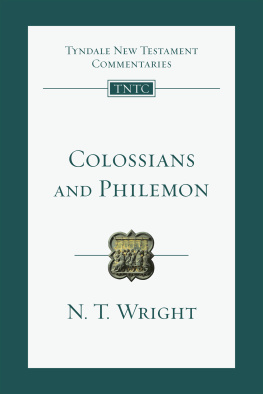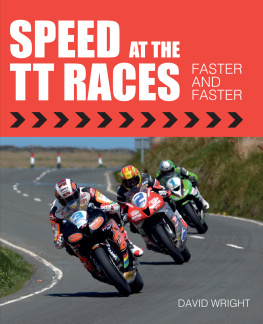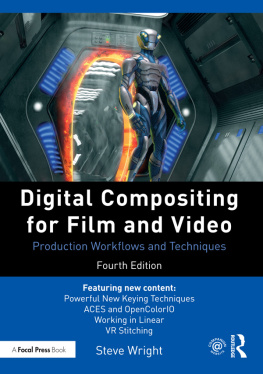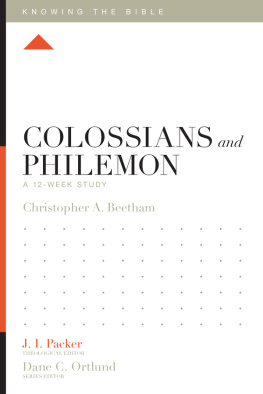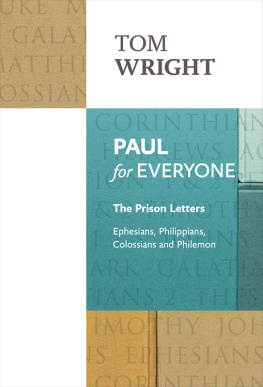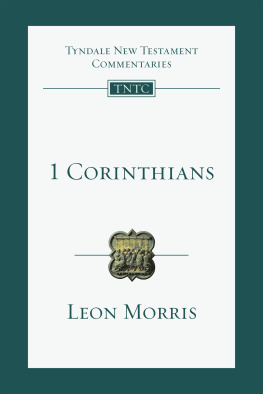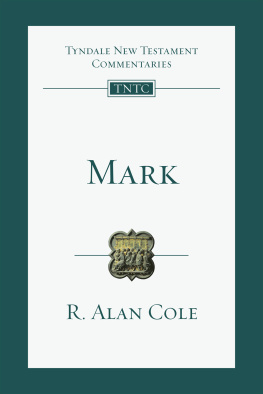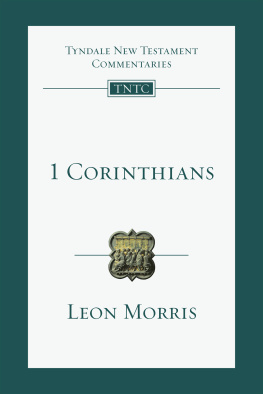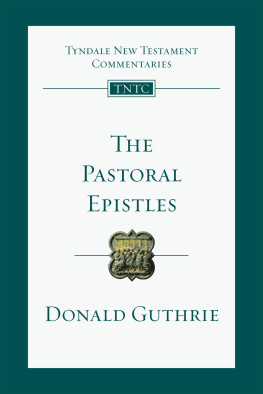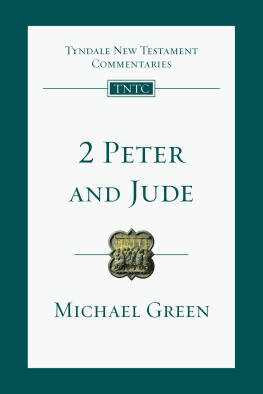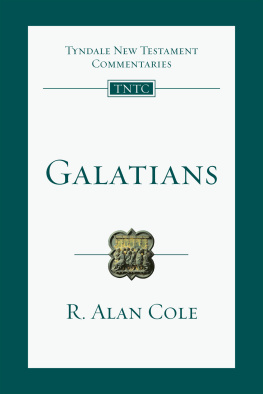TYNDALE NEW TESTAMENT
COMMENTARIES
VOLUME 12
COLLOSSIANS AND PHILEMON
TYNDALE NEW TESTAMENT
COMMENTARIES
VOLUME 12
GENERAL EDITOR: LEON MORRIS
COLLOSSIANS AND PHILEMON
AN INTRODUCTION AND COMMENTARY
N. T. WRIGHT
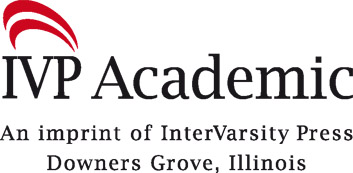
InterVarsity Press
P.O. Box 1400
Downers Grove, IL 60515-1426
World Wide Web: www.ivpress.com
E-mail:
2008 by N. T. Wright
All rights reserved. No part of this book may be reproduced in any form without written permission from InterVarsity Press.
InterVarsity Press is the book-publishing division of InterVarsity Christian Fellowship/USA, a movement of students and faculty active on campus at hundreds of universities, colleges and schools of nursing in the United States of America, and a member movement of the International Fellowship of Evangelical Students. For information about local and regional activities, write Public Relations Dept. InterVarsity Christian Fellowship/USA, 6400 Schroeder Rd., P.O. Box 7895, Madison, WI 53707-7895, or visit the IVCF website at www.intervarsity.org.
Scripture quotations, unless otherwise noted, are from the New Revised Standard Version of the Bible, copyright 1989 by the Division of Christian Education of the National Council of the Churches of Christ in the USA. Used by permission. All rights reserved.
Design: Cindy Kiple
Images:
ISBN 978-0-8308-9489-5 (digital)
ISBN 978-0-8308-4242-1 (print)
For
Richard Gorrie
and
Lori Parisi
General preface
The original Tyndale Commentaries aimed at providing help for the general reader of the Bible. They concentrated on the meaning of the text without going into scholarly technicalities. They sought to avoid the extremes of being unduly technical or unhelpfully brief. Most who have used the books agree that there has been a fair measure of success in reaching that aim.
Times, however, change. A series that has served so well for so long is perhaps not quite as relevant as when it was first launched. New knowledge has come to light. The discussion of critical questions has moved on. Bible-reading habits have changed. When the original series was commenced it could be presumed that most readers used the Authorized Version and one could make ones comments accordingly, but this situation no longer obtains.
The decision to revise and update the whole series was not reached lightly, but in the end it was thought that this is what is required in the present situation. There are new needs, and they will be better served by new books or by a thorough updating of the old books. The aims of the original series remain. The new commentaries are neither minuscule nor unduly long. They are exegetical rather than homiletic. They do not discuss all the critical questions, but none is written without an awareness of the problems that engage the attention of New Testament scholars. Where it is felt that formal consideration should be given to such questions, they are discussed in the Introduction and sometimes in Additional notes. But the main thrust of the commentaries is not critical. These books are written to help non-technical readers to understand their Bible better. They do not presume a knowledge of Greek, and all Greek words discussed are transliterated; but the authors have the Greek text before them and their comments are made on the basis of the originals. The authors are free to choose their own modern translation, but are asked to bear in mind the variety of translations in current use.
The new series of Tyndale Commentaries goes forth, as the former series did, in the hope that God will graciously use these books to help the general reader to understand as fully and clearly as possible the meaning of the New Testament.
Leon Morris
Authors preface
I well remember my first meeting with a biblical commentary. I was eighteen years old at the time, and was asked to lead a Bible Study group of six or eight contemporaries. The book we were to study was the letter to the Colossians, and the commentary which was lent to me was that by H. M. Carson, in the Tyndale series. It was just what I needed: lucid, informative, stimulating. I little thought then that I would one day be asked to write the volume that would replace it; and, when that invitation came, I accepted with a sense of gratitude, hoping that I might be able to do for another generation what Carson had done for me.
Study of Paul in general, and of Colossians in particular, has moved on by leaps and bounds in the last twenty years, and in starting again from scratch to work on the text I have tried to take account of what has been thought and written in the intervening period. This means, among other things, that I have made use of several works that, due to the different designs of various series, are able to include a wealth of technical detail that is outside the scope of this book: I think particularly of the commentaries of Lohse, Schweizer, OBrien and (on Philemon) Stuhlmacher. I have frequently found, however, that older writers such as Lightfoot, Abbott and Williams still have a rich contribution to make, and are in no way superseded by more modern studies.
My debt to Professors G. B. Caird and C. F. D. Moule extends far beyond my grateful use of their respective commentaries. Both of them have given generously of their wisdom and friendship and have helped me to understand not only the New Testament but the very nature of Christian scholarship. There are no words to express my sadness at George Cairds untimely death, which took place just after I had written the first draft of this preface. I had been looking forward eagerly to his comments on what I had written, and can now only guess at what they might have been. If this book reflects in any small way the academic rigour which he practised and taught, and the excitement which I always felt in exploring the New Testament under his guidance, I shall be proud.
Faced with the choice of basing the commentary on either the Revised Standard Version or the New International Version, I chose the latter, not because it is necessarily better but because, in my recent experience, a great many Christians have begun to use it. I have ventured to say from time to time where in my opinion its generally fine rendering of Paul could be improved. One of the good things about the plethora of modern translations currently available is that, by their very differences, they force readers of the Bible to ask searching questions about what the original text actually said. It seems to me, in this context, that the purpose of a commentary is (ultimately) to answer such questions by giving the text back to the reader uncluttered by a mass of glosses. To that end, this book has two aims: first, to clear up potential ambiguities or obscurities, so that the reader is able to hear, as nearly as possible, what the text itself says; second, to open the readers eyes to see the text, and those parts of Pauls thought which it reflects, as a whole, over and above the mass of detail. In order to achieve these objects, I have not hesitated to give my own interpretation of several major questions which are raised by the text itself. All interpreters need to arrive at some position or other from which they can survey the land before them, and I hope that those who have accustomed themselves to looking at Colossians from other angles will at least try to see it from this perspective and assess whether it makes any more sense.

